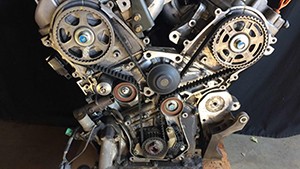
The timing belt is an internal engine component that rotates the engine’s cam and crankshaft in sync and ensures each cylinder fires at the appropriate time. The timing belt is located under a timing cover and is in the front of the engine. It’s commonly manufactured out of high-quality rubber with nylon-reinforced cords inside to extend the life of the belt. However, it is subject to incredible forces inside your motor and will need to be replaced eventually. Without a fully functioning timing belt, your engine will not run.
Not all engines have a timing belt. The timing belt is commonly found in cars and SUVs with smaller displacement engines. When an engine has a larger bore and stroke, most automotive manufacturers utilize a timing chain system that replaces the rubber belt with a metal chain. Generally, timing chains last longer than timing belts, with some rated to last the lifetime of the car. Most automotive manufacturers have a predetermined recommendation on when you should replace the timing belt, but there are a few warning indicators that a problem exists.
Listed below are a few common symptoms that might indicate that your timing belt is wearing out or has broken – which will require a mechanic to replace the timing belt and inspect other internal engine components for damage.
1. Ticking noise coming from the engine
The timing belt is attached by way of a series of pulleys to the engine’s crank and cam shaft. The crankshaft powers the engine’s connecting rods which are attached to pistons inside the combustion chamber. The camshaft operates the cylinder head valves and rocker arm assembly, which sends fuel into the combustion chamber and expels burnt gases out of the exhaust manifold. When the timing belt starts to wear out, it may create a ticking sound inside the motor. This warning sign may also be an indication of low oil pressure or the engine not having the proper amount of lubrication.
Since the timing belt is so critical to the operation of your vehicle, if you notice this warning sign, you should contact a mechanic as soon as possible.
2. Engine won’t turn over
If the timing belt has broken inside, the engine will not be able to turn over or ignite. When you turn the key, you might hear the starter motor engage, but since the timing belt operates the crank and camshaft, it will not turn over. If the issue is due to the timing belt being broken, it may also result in other internal engine compartment damage. In many cases, the timing belt will break while the engine is running. Some of the typical damage done to a vehicle with a broken timing belt includes damage to cylinder head hardware (rocker arms, push rods or valves), damage to crank bearings or the oil pump inside the oil pan.
A professional and experienced mechanic will know how to inspect all of these supporting components if the timing belt needs to be replaced.
3. Engine misfires
A worn out timing belt might also impact the engine’s fire rate. The timing belt is attached to pulleys that drive the crank and camshaft as we’ve indicated above. However, sometimes the belt will slip on the camshaft drive and cause one cylinder to open or close earlier than it should. This might cause a misfire situation and if not replaced soon, may result in catastrophic engine damage.
4. Oil leaking from in front of the motor
It’s also typical that the engine will leak motor oil from the timing belt cover. The cover is secured by a series of nuts and bolts that may come loose over a period of time. Another issue that will cause oil to leak is when the gasket between the engine block and timing cover wears out, is cracked or has been improperly installed and is pinched. Leaking oil from the timing belt cover commonly results in engine overheating and can prematurely wear the timing belt.
Often, it’s difficult to discover a problem with the timing belt until it’s too late and has broken. However, you should check with your vehicle’s manufacturer to determine when the replacement interval is scheduled and replace the belt within that time period.
This article comes from autoblog edit released
